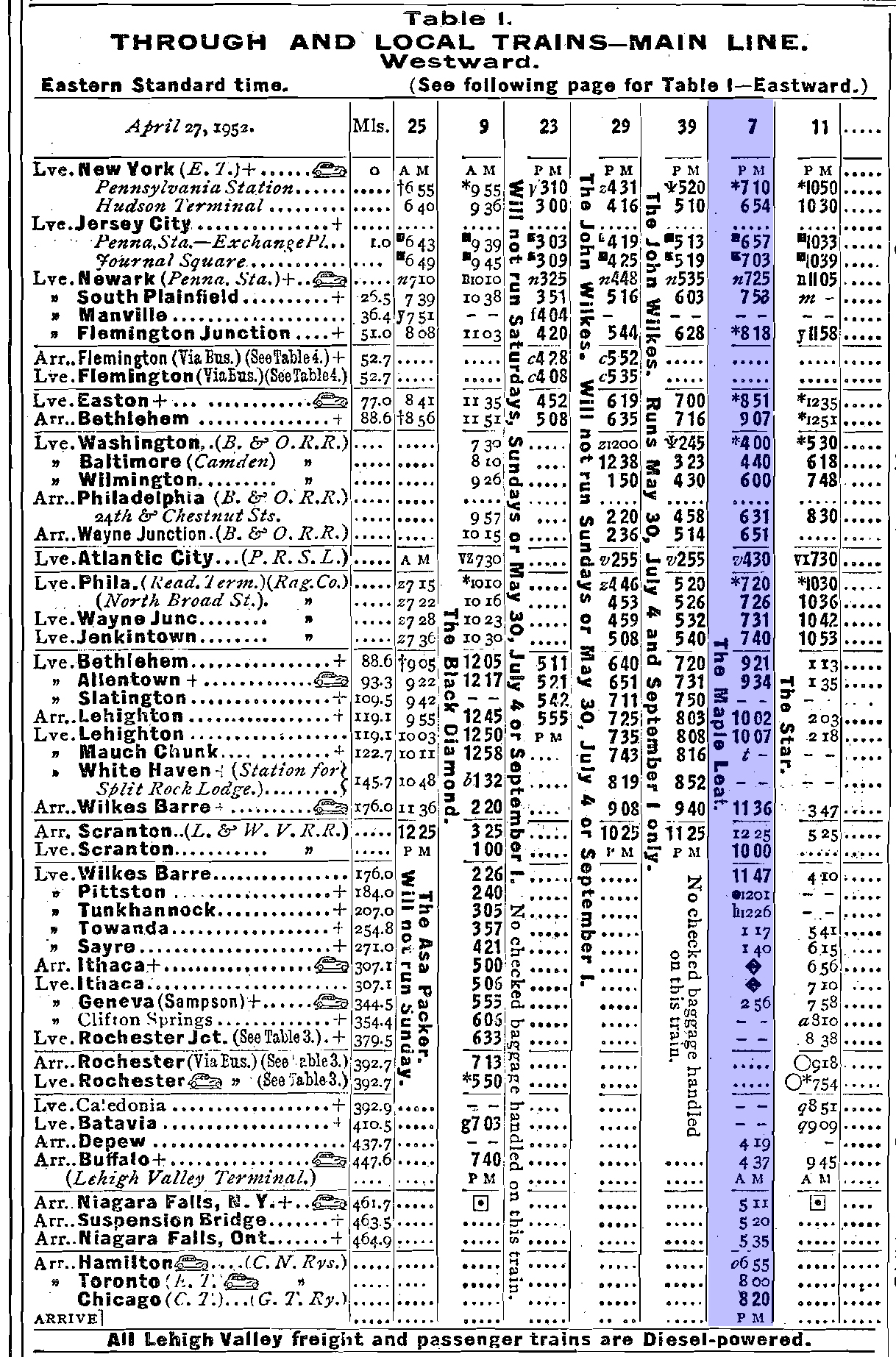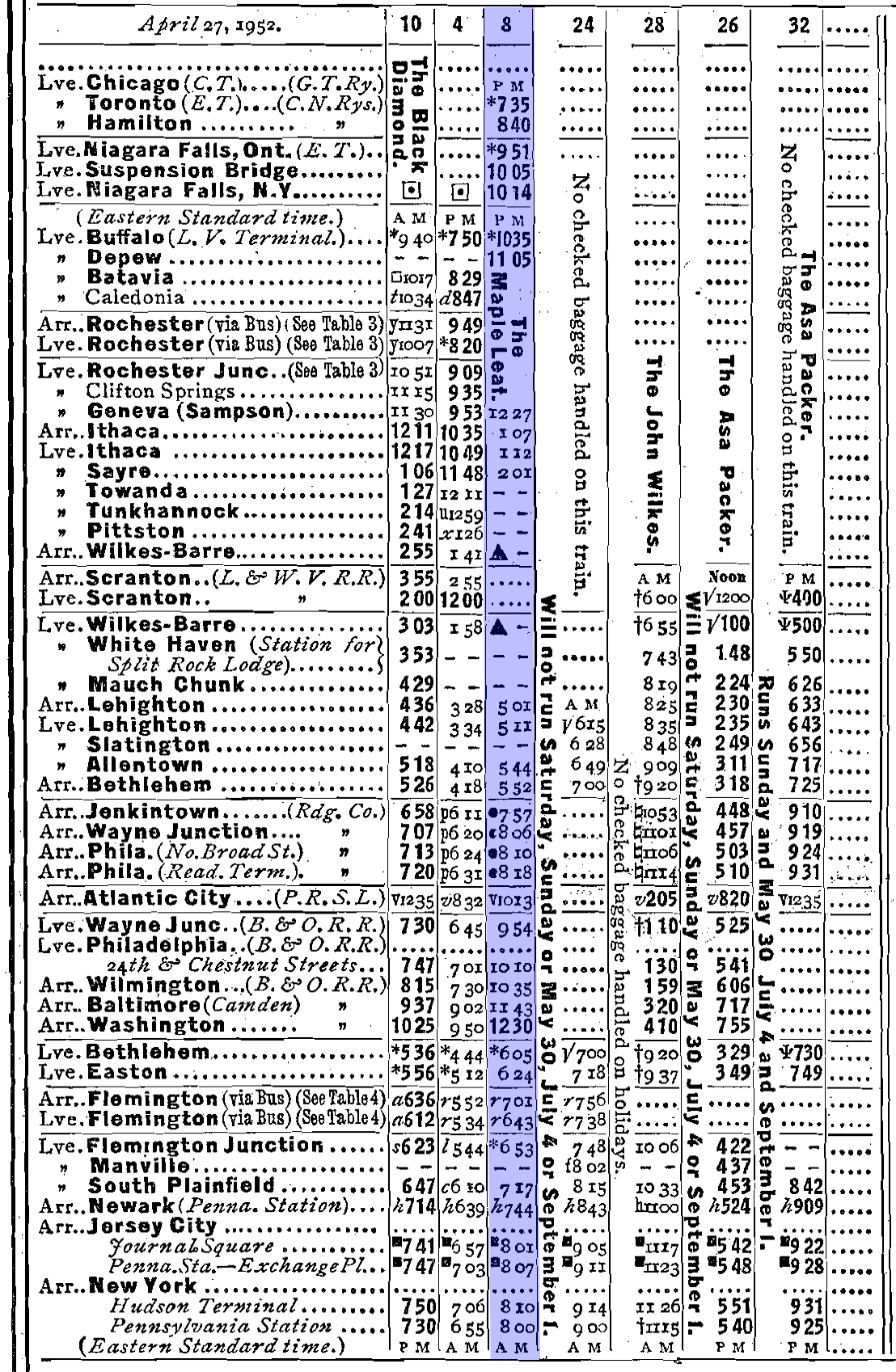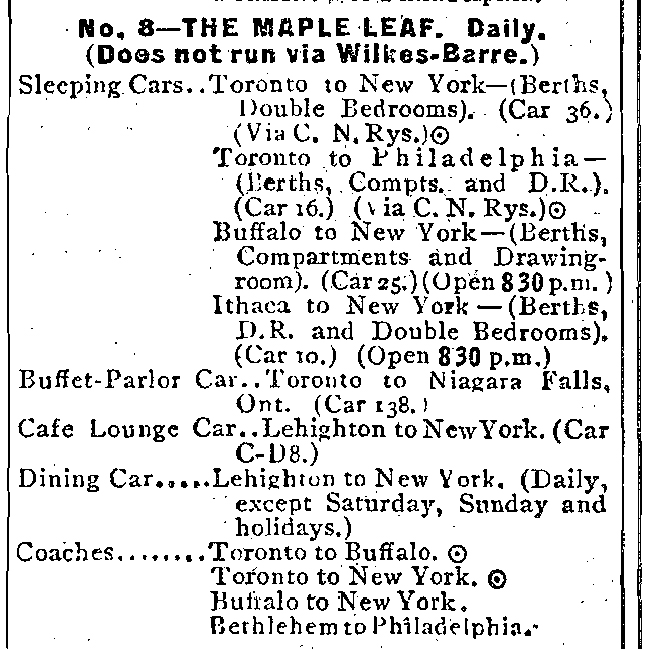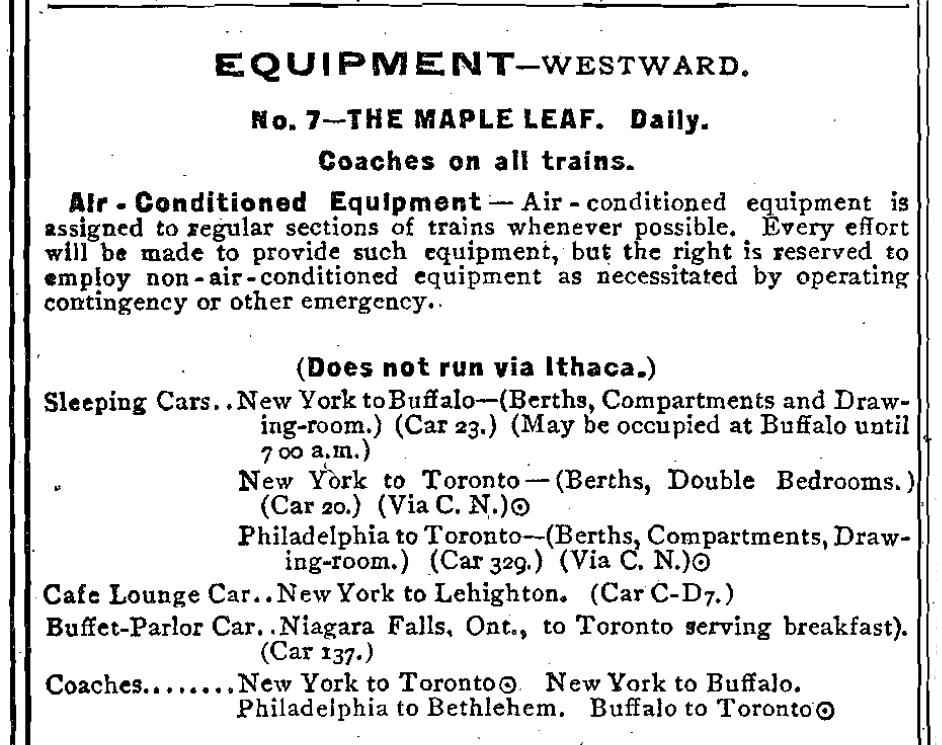The "Maple Leaf": An LV-CN International Service
Published: October 25, 2024
By: Adam Burns
Historically, the Maple Leaf was one of two different named trains reaching Toronto from the United States. One was a Grand Trunk Western service operating via Chicago and Detroit while the other was a Lehigh Valley train linking New York and Buffalo.
The LV's service was inaugurated in 1937 and ran in conjunction with the Canadian National providing through service from PRR's Pennsylvania Station to Toronto Union Station.
The Maple Leaf had a somewhat interesting route; the eastbound train did not operate via Wilkes-Barre while the westbound run bypassed Ithaca.
The LV was always the slowest, and most rugged, New York-Buffalo routing. As a result, the Maple Leaf - and the railroad's long-distance trains - were discontinued early with this international train making its final run on February 3, 1961. Amtrak revived the name in 1981 and it connects the same cities.
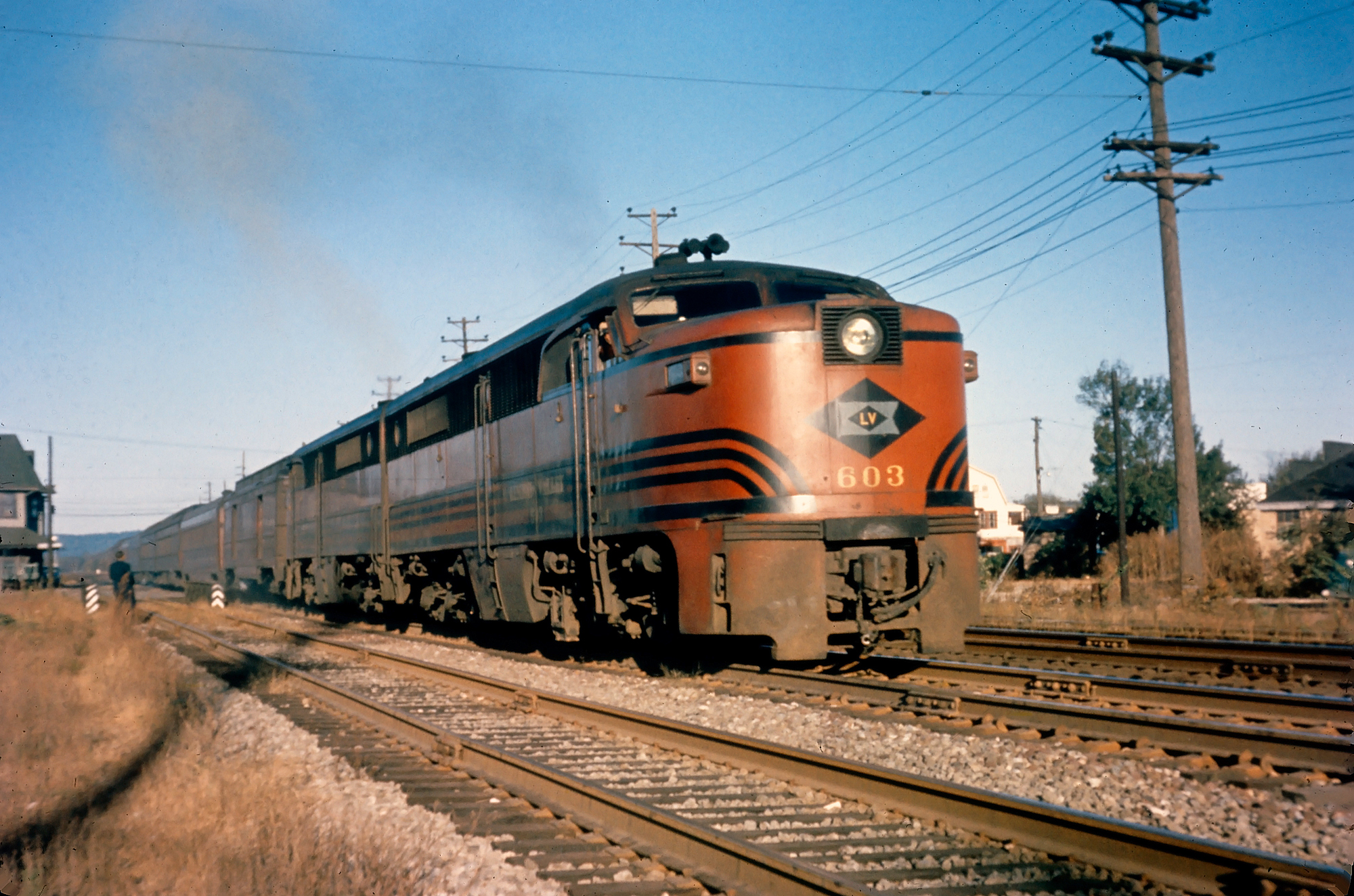 Lehigh Valley PA-1's, led by #603, have train #8, the eastbound "Maple Leaf," hustling through South Plainfield, New Jersey on a fall morning, circa 1952. Meyer Pearlman photo. American-Rails.com collection.
Lehigh Valley PA-1's, led by #603, have train #8, the eastbound "Maple Leaf," hustling through South Plainfield, New Jersey on a fall morning, circa 1952. Meyer Pearlman photo. American-Rails.com collection.Genesis
The roots of the Maple Leaf trace back to the early 20th century, a time when rail travel was witnessing a revolution in the United States. The Lehigh Valley, established in 1847 as the Lehigh, Schuylkill & Susquehanna Railroad, primarily transported anthracite coal from Pennsylvania's northeastern mines to larger markets like New York City and Philadelphia.
As the system grew - eventually peaking at nearly 1,400 route miles through the early 20th century - it expanded its passenger services. The Maple Leaf was introduced in 1937, a renaming of what had been the Toronto which operated the same routing.
Design and Features
The Maple Leaf was designed to reflect the pinnacle of comfort and innovation of its time. When the train was entered service the LV was in its final decade of steam and primarily utilized K Class 4-6-2s for passenger assignments.
It was never streamlined but from the start featured many on-board amenities. In 1940 these included air-conditioning; sleepers reaching Chicago, Philadelphia, Buffalo, and Toronto; full dining service (New York-Easton and Port Huron-Chicago); a cafe-parlor (Niagara Falls-Toronto); a club-diner (New York-Wilkes-Barre); and buffet-parlor (Hamilton-Port Huron).
Interestingly, all of these services were still offered through the early 1950s, a time when the Lehigh Valley's financial situation was rapidly declining.
Route and Significance
The Maple Leaf benefited from a picturesque routing, including the northern Appalachian Mountains, Finger Lakes region, and the rolling hills of Southern Ontario, offering passengers a visual treat alongside their journey.
Timetables (1952)
The Golden Era
For several decades, the Maple Leaf operated in what could be defined as a golden era for passenger rail. Competing with automobile travel and, eventually, airline services, railroads like the LV enhanced their offerings to attract travelers.
With the acquisition of fourteen new PA-1s from Alco in 1948, #601-614, the train became diesel-powered although still operated with heavyweight equipment clad in the railroad's handsome Cornell Red.
Challenges and Decline
The post-World War II period marked the beginning of the challenges for the Maple Leaf, as with many other passenger trains. The rise of automobile ownership and the expansion of the highway networks contributed to a decline in rail travel. Furthermore, the advent of commercial air travel offered speed that railroads couldn't match.
Despite efforts to modernize and promote the service, the Maple Leaf could not entirely reverse the declining passenger numbers. Financial pressures and changing travel preferences forced the LV to reevaluate its services.
As the 1960s progressed, the pressures mounted. Railroads across America were grappling with maintenance challenges and operational costs, and the Lehigh Valley was no exception. The economic realities led to reduced services and, ultimately, the cessation of the Maple Leaf as a passenger service.
In his book, "More Classic American Railroads," author Mike Schafer notes the Transportation Act of 1958 enabled the LV to petition the Interstate Commerce Commission to discontinue all remaining passenger services.
By then the railroad had not turned a profit since 1956 and would never do so again before joining Conrail in 1976. The anthracite coal business had greatly declined in the post-World War II years as home and commerical heating switched from coal to natural gas.
The Maple Leaf would go on to make its final run on February 3, 1961, marking the end of all remaining passenger services across the railroad that year.
Legacy and Impact
Though the Maple Leaf eventually ceased operations, its legacy endures in the annals of American railroad history. It is remembered as a train that epitomized an era of elegance and transportation excellence.
Amtrak, which eventually absorbed many of the passenger routes from defunct rail lines, revived the Maple Leaf name in 1981 for its Toronto-New York service, a tribute to its historic predecessor.
Consist (1952)
Conclusion
The story of the Maple Leaf is more than just a chronicle of a train service. It's a reflection of a time when railroads were a vital thread in the social and economic fabric of North America. It is about the relentless pursuit of comfort and speed, the challenge of staying relevant in evolving times, and the nostalgic draw of travel.
The Maple Leaf remains a cherished memory among railroad enthusiasts and is celebrated for its contribution to connecting communities across regions. Its history serves as a reminder of the importance of innovation and adaptation in the face of changing times.
Recent Articles
-
Alabama's - Wine Tasting - Train Rides
Jan 10, 26 09:29 AM
While the state might not be the first to come to mind when one thinks of wine or train travel, the unique concept of wine tasting trains adds a refreshing twist to the Alabama tourism scene. -
Maryland Dinner Train Rides At WMSR!
Jan 10, 26 09:13 AM
The Western Maryland Scenic Railroad (WMSR) has become one of the Mid-Atlantic’s signature heritage operations—equal parts mountain railroad, living museum, and “special-occasion” night out. -
Arkansas Dinner Train Rides On The A&M!
Jan 10, 26 09:11 AM
If you want a railroad experience that feels equal parts “working short line” and “time machine,” the Arkansas & Missouri Railroad (A&M) delivers in a way few modern operations can. -
South Dakota's - Murder Mystery - Dinner Train Rides
Jan 10, 26 09:08 AM
While the state currently does not offer any murder mystery dinner train rides, the popular "1880 Train" at the Black Hills Central recently hosted these popular trips! -
Wisconsin's - Murder Mystery - Dinner Train Rides
Jan 10, 26 09:07 AM
Whether you're a fan of mystery novels or simply relish a night of theatrical entertainment, Wisconsin's murder mystery dinner trains promise an unforgettable adventure. -
Missouri's - Murder Mystery - Dinner Train Rides
Jan 10, 26 09:05 AM
Missouri, with its rich history and scenic landscapes, is home to one location hosting these unique excursion experiences. -
Washington ~ Murder Mystery ~ Dinner Train Rides
Jan 10, 26 09:04 AM
This article delves into what makes murder mystery dinner train rides in Washington State such a captivating experience. -
Kentucky Scenic Train Rides At KRM!
Jan 09, 26 11:13 PM
Located in the small town of New Haven the Kentucky Railway Museum offers a combination of historic equipment and popular excursions. -
Washington "Wine Tasting" Train Rides
Jan 09, 26 08:53 PM
Here’s a detailed look at where and how to ride, what to expect, and practical tips to make the most of wine tasting by rail in Washington. -
Kentucky's - Wine Tasting - Train Rides
Jan 09, 26 08:21 PM
Kentucky, often celebrated for its rolling pastures, thoroughbred horses, and bourbon legacy, has been cultivating another gem in its storied landscapes; enjoying wine by rail. -
Kentucky's - Murder Mystery - Dinner Train Rides
Jan 09, 26 01:12 PM
In the realm of unique travel experiences, Kentucky offers an enchanting twist that entices both locals and tourists alike: murder mystery dinner train rides. -
Utah's - Murder Mystery - Dinner Train Rides
Jan 09, 26 01:05 PM
This article highlights the murder mystery dinner trains currently avaliable in the state of Utah! -
North Carolina Dinner Train Rides At NCTM!
Jan 09, 26 12:51 PM
Tucked into the Piedmont town of Spencer, the North Carolina Transportation Museum is the kind of place that feels less like a typical museum and more like a living rail yard that never quite stopped… -
Tennessee Dinner Train Rides At The TVRM!
Jan 09, 26 12:39 PM
Tucked into East Chattanooga, the Tennessee Valley Railroad Museum (TVRM) is less a “museum you walk through” and more a railroad you step aboard. -
New York Scenic Train Rides On The A&A!
Jan 09, 26 11:20 AM
The A&A is both a common-carrier short line moving freight and a heritage railroad hosting popular excursion trains, all on the same storied right-of-way. -
Pennsylvania Scenic Train Rides In Hollidaysburg!
Jan 09, 26 11:14 AM
Tucked into the Juniata River valley just south of Altoona, the Everett Railroad offers one of the most approachable—and photogenic—heritage-rail experiences in Pennsylvania -
Montana Dinner Train Rides Near Lewistown!
Jan 08, 26 03:03 PM
The Charlie Russell Chew Choo turns an ordinary rail trip into an evening event: scenery, storytelling, live entertainment, and a hearty dinner served as the train rumbles across trestles and into a t… -
Alabama's - Murder Mystery - Dinner Train Rides
Jan 08, 26 02:19 PM
There is currently one location in the state offering a murder mystery dinner experience, the Wales West Light Railway! -
Rhode Island's - Murder Mystery - Dinner Train Rides
Jan 08, 26 01:43 PM
Let's dive into the enigmatic world of murder mystery dinner train rides in Rhode Island, where each journey promises excitement, laughter, and a challenge for your inner detective. -
Florida's - Wine Tasting - Train Rides
Jan 08, 26 01:13 PM
Wine by train not only showcases the beauty of Florida's lesser-known regions but also celebrate the growing importance of local wineries and vineyards.

